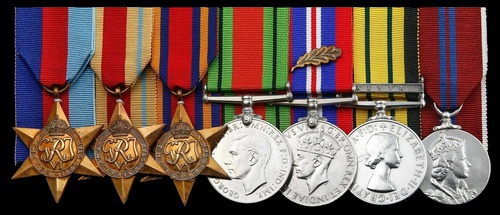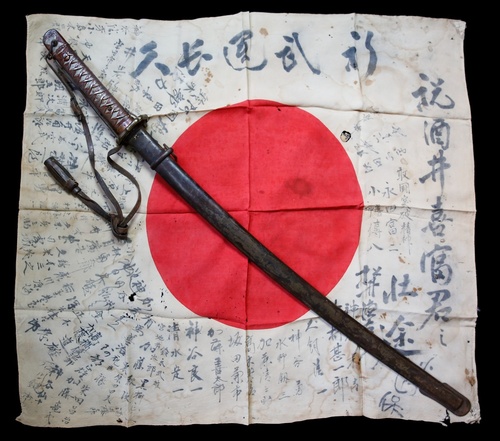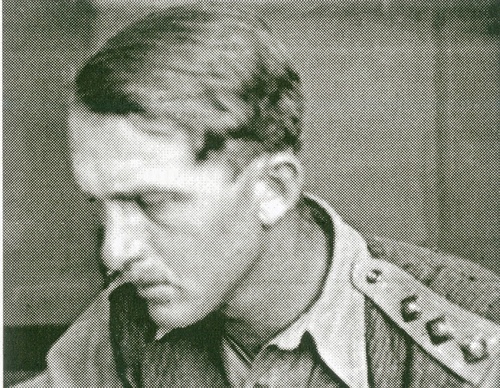Auction: 17003 - Orders, Decorations and Medals
Lot: 596
A fascinating Second World War and Mau Mau operations campaign group of seven awarded to Major A. Wolseley-Lewis, Kenya Regiment and King's African Rifles
His extraordinary life - at war and as an old Kenya hand - is vividly recounted in the pages of his forthright autobiography Empire to Dust: from his account of a telling ambush on a Japanese patrol - from which he came away with a sword and blood-stained Imperial 'Rising Sun' flag - to his compelling pronouncement on the identity of the 'White Mischief' murderer of 'Joss' Hay, Earl of Erroll, in February 1941
Such experiences - and opinions - made him a perfect interviewee for Lord Steel in Channel 4's Empire's Children series in 2007, for he continued to fly the flag for like-minded ex-Kenya hands such as the delightful - and unforgettable - Hilary Hook of Home from the Hill fame: both deeply appreciated the wonderful life that the colony had afforded them
1939-45 Star; Africa Star; Burma Star; Defence and War Medals 1939-45, M.I.D. oak leaf; Africa General Service 1902-56, 1 clasp, Kenya (E1607 I.P.I. (R.) A. Wolseley-Lewis); Coronation 1953, minor official correction to surname on the last, generally very fine or better (7)
Arthur Wolseley-Lewis was born on 8 September 1911, the son of Dr. H. W. Lewis, and was educated at Marlborough College, where he played rugby for the 1st XV.
Active service
His subsequent ambition to become a farmer in Kenya was interrupted by the outbreak of hostilities in September 1939, when he enlisted in the Kenya Regiment; he had earlier been a member of the colony's Defence Force.
Subsequently commissioned in the 6th King's African Rifles, he transferred to 3/4th K.A.R. as a Mortar Officer and caught the tail end of the campaign against the Italians in Abyssinia in 1941. To his dismay, it proved a difficult 'tail' to catch, for the Italians were in full retreat. He was afterwards employed in operations against the Vichy French in Madagascar but - for his part - these also proved to be of the non-combatant kind.
It was about this time that personal tragedy struck. His wife, Ann, whom he had married in 1940, was drowned when her ship, the S.S. Khedive Ismail, was torpedoed off the Maldives in February 1942. She was on her way to Ceylon as a Nursing Sister in the East African Military Nursing Service.
In Burma, he found plenty of opportunity to avenge her death and to distinguish himself, winning a mention in despatches (London Gazette 27 September 1945, refers). His autobiography speaks in volumes of hardships suffered and of a determination to seek out and destroy the enemy:
'We had to try and exterminate the vermin, who stayed in their fox-holes and had to be destroyed by fire. They were there to delay us and they did. I am afraid we really enjoyed killing them. For me, having lived like an animal, at the best under canvas, I was going to find it difficult to become socially human again.'
At Imphal the scene resembled a First World War battlefield:
'The ground was all pockmarked with shell craters and the trees were broken stumps. There was the usual litter of battle, broken weapons, empty shell cases, ammunition boxes, etc., scattered all over the place … The smell was appalling, but in time we got used to it. There were hundreds of dead and others were dying of beri-beri, malnutrition, malaria, wounds, no food and no medical care. The Japanese Imperial Army had abandoned them.'
It was in the subsequent advance to the Chindwin that Wolseley-Lewis obtained some memorable trophies of war:
'The next bit of excitement we had was when a Jap position had been attacked and an officer, Ted Onslow, had been wounded and lost an eye. 'B' Company was sent to try and catch this lot trying to retire. I laid an ambush at a river crossing, not that there was much water in it. We caught them and in a brief action killed six of them, including the leader, who was an N.C.O., but carried a sword and the gang's flag with their names on it. I still have them!'
The crossing of the Chindwin was undertaken in rubber dinghies:
'The river in the middle was flowing very rapidly and this was the biggest problem. It was at night and I ordered everyone to unbuckle their equipment, so that if they capsized they would not go straight to the bottom. One lot did turn over and drowned; another lot ended up a mile downstream, but the majority made it near enough to the rendezvous on the other bank. I must admit I was in a pretty good funk, not knowing whether there would be a burst of machine-gun fire while we were in midstream and unable to retaliate … the Jap Zeros did come over but were seen off with anti-aircraft fire.'
On being rested from active service, Wolseley-Lewis opted to return to the U.K. to see his parents.
'I was in a sort of state of limbo and could not adjust. I was mentally in a state of shock or deadened by malaria. I was very thin and unable to eat much because I had been used to concentrated foods. I was a very difficult person, bad-tempered, argumentative, stubborn and a sick man. My poor parents gave me a great welcome, but they had not seen me for 15 years and I was a stranger. They wanted to love and understand me, but had no idea how to go about it.'
Old Kenya hand
Wolseley-Lewis returned to Kenya and achieved his ambition to become a farmer.
During the Mau Mau troubles in the 1950s he served as Police Reservist and truck loads of British troops were entertained at his farm with home-made food and comforts. Such generous hospitality came at an additional cost for, in 1953, whilst he and his second wife were away on their regular monthly shopping trip, the Mau Mau burnt the farm down.
Farming aside, Wolseley-Lewis served as Executive of St. John Ambulance during the first visit of Pope John Paul to Kenya. In retirement, he settled in the Nairobi area, where he was much in demand as a talented wildlife artist.
In his autobiography Empire to Dust (2007), Wolseley-Lewis reflected on all manner of subject matter in respect of his days in Kenya. Notable among his observations in respect of the "Happy Valley" set was his forthright pronouncement on the identity of the murderer of 'Joss' Hay, Earl of Erroll, in February 1941. He dismissed modern-day speculation as 'mumbo jumbo' and named the murderer as an ex-cavalry officer in the pay of Secret Intelligence Service: his evidence was based on the fact that the assassin went straight to his own aunt's house after firing the fatal shot.
A 'masterly bridge and snooker player', Wolseley-Lewis died on 16 February 2008, shortly after his appearance in Channel 4's Empire's Children series.
Sold with the following artefacts and original documentation:
(i)
A Japanese Army sword, with scabbard and leather tassels, and Imperial 'Rising Sun' flag, as taken by the recipient in the above described ambush, the latter with ink signatures and dedications.
(ii)
M.I.D. certificate in the name of 'Major (Temp.) A. Wolseley-Lewis, General List, Infantry', dated 27 September 1945; together with War Office letter of thanks for services rendered, dated 26 June 1946, and his release certificate.
(iii)
Certificate of appointment as a Reserve Police Officer, Colony of Kenya, dated 9 September 1949.
(iv)
A copy of his autobiography, Empire to Dust.
Subject to 20% VAT on Buyer’s Premium. For more information please view Terms and Conditions for Buyers.
Sold for
£2,200









